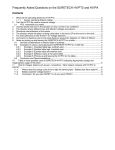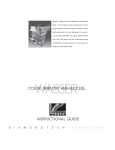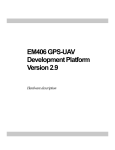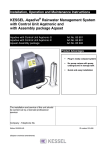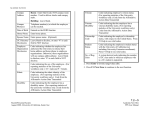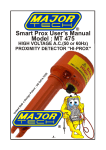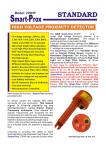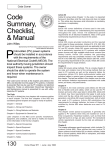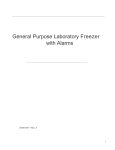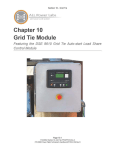Download Frequently Asked Questions on the SURETECH HV/PT2
Transcript
Frequently Asked Questions on the SURETECH HV/PT2 Contents Frequently Asked Questions on the SURETECH HV/PT2 .............................................................. 1 Varying results that exist in the situation of rainy, humid or dry conditions. ..................................... 1 The situation where different lines and different voltages are present............................................. 1 Directional characteristics of the sensor ......................................................................................... 1 The situation where the tester is being used either in the hand, OR at the end of a link stick.......... 2 For strict adherence to IEC 61243-1 for Voltage detectors ............................................................. 2 Comments on flashover due to the small distance required for detection of 132kV of 250mm........ 2 Notes on picking up and leaving the SURETECH HV/PT2 on a table ............................................. 2 General considerations of electric fields in buildings ................................................................... 2 Examples of various users placing the SURETECH HV/PT2 on a table top ................................ 2 Example 1 (Insulated table legs, earthed user)........................................................................ 2 Example 2 (Earthed table legs, insulated user)........................................................................ 3 Example 3 (Earthed table and earthed user) ........................................................................... 3 Example 4 (Different users at the same table) ......................................................................... 3 Example 5 (Picking up and leaving the HV/PT2 on the table) .................................................. 3 Conclusion and Recommendations............................................................................................. 3 Table of some possible uses of SURETECH HV/PT2L indicating Appropriate useage and Inappropriate usage of the tester: ................................................................................................... 5 Varying results that exist in the situation of rainy, humid or dry conditions. Under humid or wet conditions, corona discharge can occur even at medium voltages. Corona discharge creates short impulses often less than one micro second, and spaced apart by tens of micro seconds. The result is high frequency energy that is available to be coupled into the proximity sensor. Due to the capacitive coupling of proximity sensors, the coupling to this high frequency energy is much stronger than at 50Hz, so spurious triggering results in some proximity testers leading to uncertainty in operating distance. This is fundamental to the consistency of operating distance with proximity sensors, which has led to much uncertainty with users of these devices. Guided by ESKOM in 1995-1997 we embarked on the development of a fundamentally new way of sensing to filter out the effects of corona discharge. The consistency of operating distance which the HV/PT2 exhibits is very good even under varying conditions. Our HV/PT2 was approved by ESKOM in June 1998, and we understand that it is the only ESKOM approved proximity tester. (As a by-product of this new technology that we developed has come a range of highly accurate sensors - see our website http://www.suretech.co.za , and many more products will be developed in the years to come.) The situation where different lines and different voltages are present The use of the proximity sensor on a link stick on VARIOUS voltage settings, enables the user to assess the ACTUAL VOLTAGE on the line. This is particularly important when a line has for example just been tripped, and the user needs to establish the following: whether THIS particular line as been tripped, and if so whether the line is receiving a BACKFED voltage OR, whether the line is subject to an INDUCED VOLTAGE from an adjacent line, OR has no appreciable voltage on it. The induced voltage could be lower, but CAN STILL BE LETHAL. It is advisable to cross-check by assessing the actual voltage level. This is achieved by observing the operating distance graphs in the HV/PT2 User Manual or brochure. Directional characteristics of the sensor When used in the hand, HV/PT2 has a Cosine response characteristic. When used at the end of a link stick, the user should be aware of the electric field pattern for most effecitve results. For advanced users we offer a training course in the nature of electric fields, and how they are affected in the measuring process. The situation where the tester is being used either in the hand, OR at the end of a link stick For the higher voltages, a link stick deployed HV/PT2 can return more accurate assessment of voltage on a particular line. By doing measurements close to the line using a link stick (rather than hand use), enables the user to establish (by measuring the electric field NEAR the conductor) much more accurately what the voltage is on THAT particular line. For strict adherence to IEC 61243-1 for Voltage detectors A link stick adapter probe spacer is available for direct conformance to the standard. To use the tester as an extension to the standard, the user should consult the factory Comments on flashover due to the small distance required for detection of 132kV of 250mm The Occupational Health and Safety-Act requires the larger distance (you gave 1.3m), but this is for absolute minimum OPERATOR WORKING CLEARANCE. The working clearance at the end of the link stick, is the link stick length itself, (assuming the link stick has been approved, tested and is clean etc.) The HV/PT2 can even be placed onto the 132kV line without damage to itself or danger to the operator, so long as the link stick is safe. It is however not good practice to place the HV/PT2 onto the HV line, as the field can be extremely high at the conductor, and subjecting the tester to localised discharge which can degrade the box insulation (see User Manual for further information). This is however not dangerous to the operator. Correct use is to move the HV/PT2 nearer and further away from the line about 250mm distance on the correct voltage setting. The tester should beep around that operating distance. Notes on picking up and leaving the SURETECH HV/PT2 on a table General considerations of electric fields in buildings • • • • • • • • Stray electric fields from the 220Vac (or 110Vac) mains will couple with all items in a room; these items include humans as well as furniture such as tables, chairs, floors, walls etc. Each of these items will be capacitively coupled to the mains live conductors depending on where the mains cable is relative to a given item Mains generated electric fields will be present from mains socket outlets and lighting. If there is an electrical appliance connected to the plug, then the cable connecting the appliance to the mains will also contribute to generating the electric field that capacitively couples to the item. Now each of the above mentioned items itself will have electrical properties including a capacitive dielectric constant that will act to channel more or less of the electric field For example the dielectric material of a plastic table will channel the electric field through it at a factor of 5 times greater than that of air (assuming the relative permittivity of the plastic table is 5) If the table is wood, then perhaps there is water content in the wood which will tend to reduce the electric field, or possibly make the entire table top at the same potential, which may or may not be at earth potential Depending on the electrical properties of the table legs, they could either connect the table top to the floor (which is probably at earth potential, but not always) Remember that a magnetic field is not the same as an electric field. The magnetic field is set up from the presence of a current, and an electric field is set up from the presence of a voltage Examples of various users placing the SURETECH HV/PT2 on a table top Example 1 (Insulated table legs, earthed user) • If the table legs are insulated from earth (eg. dry wood, or non-conducting plastic) then there will not be a discharge path from the table top to earth, and the table top could easily be at a potential of a hundred volts or more above earth, if an electric cable was close by • Now if a user at earth potential (bare feet) holds a SURETECH HV/PT2 near to the table, then the HV/PT2 will detect the presence of this voltage and it will beep • • All the user needs to do is touch the table with his other hand and thereby equalise the table top voltage to his body, then the HV/PT2 will stop beeping In this case the user is earthed and the table top is live Example 2 (Earthed table legs, insulated user) • Assume a table is conductive and is resting on (electrically connected to) earth, then any capacitively coupled current from stray electric fields (from mains cables) will be coupled to earth • This will result in the table being at earth potential (ie. zero volts) and it will conduct any small stray capacitively coupled currents to earth • Then lets assume the HV/PT2 operator is wearing rubber soled (electrically insulated) shoes, and thereby making the user electrically insulated from earth • Lets also assume that the user is near a mains cable, such as a light in the ceiling or cable connected to an electrical appliance. The appliance does not even have to be ON, and there still will be an electric field from the live trailing cable • This electric field will capacitively couple to the user, thereby making him / her live at a voltage depending on the capacitive coupling distance, and insulation properties of the user's shoes, as well as the mains voltage • Now when the user brings the HV/PT2 near to the table top, the tester will most probably beep just before it touches the table • Again the tester is doing what it is supposed to do, by detecting a voltage difference between the user and the table top • In this case the user is live and the table top is earthed Example 3 (Earthed table and earthed user) • Assume a conductive table top, and a user that are BOTH connected to earth, with electric cables far away • An approaching HV/PT2 will not beep because the table and the operator are at the same potential • The HV/PT2 again behaves correctly Example 4 (Different users at the same table) • Assume one operator is at the one end of the table, and another operator is at the other end of the table • Various combinations of table electrical properties, shoe properties of both users, and where the electric cables in the environment couple their electric field, will determine whether the user AND / OR the table top will be live OR at zero volts, and whether the users are live or at zero volts • Whenever there is a potential difference between a user and the table, the tester will beep just before (and perhaps after) the tester touches the table Example 5 (Picking up and leaving the HV/PT2 on the table) • When the HV/PT2 is left resting on the table without the user holding it, it will take up the same potential as the table and it will stop beeping as the user moves away • If a user approaches an HV/PT2 that is resting on the table top, just before he touches it, the tester will beep if there is a voltage difference between the user and the table top Conclusion and Recommendations • • • We all live in and around stray electric fields in our homes, which are set up by electric cables carried through walls, cables to appliances and lighting The SURETECH HV/PT2 is very sensitive to these electric fields. It is electric fields that the HV/PT2 has been designed to detect. The electric field contains all of the information of the voltage on the conductor that causes the electric field. Even for low voltages (tens of volts), the HV/PT2 can detect these voltages when it is held very close. • • When an HV/PT2 is placed on a table or any other surface and beeps, then the tester is doing what it is supposed to do, by detecting a difference in voltage between the user of the instrument, and the table (or other surface) Users of HV/PT2 should not jump to the conclusion that the tester is faulty if it behaves differently with different users; they are probably occupying different space in the room and therefor are at a different voltage; and they may have different characteristics of shoe insulation from each other Table of some possible uses of SURETECH HV/PT2L indicating Appropriate useage and Inappropriate usage of the tester: The table indicates some typical uses of HV/PT-2L. The table is by no means exhaustive, and is meant to be a guide: Scenario 3 phase 11kV, (or 380V etc) cable buried in ground 3 phase 11kV (or 380V etc) cable, phases exposed, separated but insulated 220V live / neutral / earth Cab-tyre cable Test Cable armouring Appropriate use of HV/PT-2L If an earth on some part of the power system is removed (or stolen), then remaining cable armouring could easily become live and dangerous. Under these circumstances the armouring could become live and dangerous. HV/PT-2L will pick up any voltage on the armouring of the cable. HV/PT2L operating distance will give an indication of the voltage. Individual HV/PT-2L used with phases SURETECH handle (11kV or 50Kv) will provide an estimate of voltage on each phase. User should be able to differentiate between a backfeed voltage versus induced voltage, both of which could be lethal Test outside HV/PT-2L will operate at about cable to see 30mm hand held whether cable is energised 220V live only Test through insulation HV/PT-2L will operate at about 100mm hand-held Telkom line running on shared service poles under ESKOM / Municipal MV line Test TELKOM cable screen nearby to MV line Only skilled technicians who have been specially trained should be allowed to operate on or near live MV equipment, closer than the safe approach distances specified by ESKOM. The HV/PT-2L (or preferably HV/PT2) can be used by a skilled technician. Inappropriate use of HV/PT-2L DON'T EXPECT TO SEE WHETHER A CABLE IS LIVE THROUGH THE ARMOURING!!!! Under normal circumstances, the armouring will be earthed and will also kill the electric field generated by the conductors in the cable Can use HV/PT-2L hand-held, but operator's hand should never encroach closer than the safe operating distance Don't hold a live insulated cable in one hand TOO CLOSE THE POINT OF MEASUREMENT, and the other hand holding the HV/PT2L tester. The operators hand that is holding the cable will kill the electric field, thereby de-sensitising HV/PT-2L Don't hold a live insulated cable in one hand TOO CLOSE THE POINT OF MEASUREMENT, and the other hand holding the HV/PT2L tester. The operators hand that is holding the cable will kill the electric field, thereby de-sensitising HV/PT-2L Close proximity to the MV line should be avoided as the electric field of the MV line could predominate, depending on the exact geometry of the situation Telkom line running on shared service poles under ESKOM / Municipal MV line Test TELKOM cable screen FAR AWAY from MV line, e.g. inside TELKOM junction box Telkom line running NEARBY ESKOM / Municipal overhead MV line Telkom line running NEARBY ESKOM / Municipal overhead MV line Test TELKOM cable screen NEARBY the MV line LV bundled cable LV bundled cable is not screened, and so voltage present on each phase can be tested MV bundled cable is screened and the screen is normally earthed. MV bundled cable Test TELKOM cable screen FAR AWAY from MV line, e.g. inside TELKOM junction box It should be standard practice for technicians to test for HV whenever they open a junction box. A hand-held HV/PT-2L can be used, to determine whether a MV line has fouled with the Telkom line SOMEWHERE ELSE in the system. If a high voltage is present in the junction box, then a more accurate assessment of voltage should be made with the HV/PT-2L on a SURETECH handle. HV/PT-2L can be used handheld or with SURETECH handle. DON'T EXPECT TO SEE WHETHER HV IS PRESENT WITHIN A JUNCTION BOX THROUGH THE STEEL DOOR!!!! Under normal circumstances, the door and junction box will be earthed and will eliminate any electric field generated by HV conductors inside the junction box. It should be standard practice for technicians to test for HV whenever they open a junction box. A hand-held HV/PT-2L can be used, to determine whether a MV line has fouled with the Telkom line SOMEWHERE ELSE in the system. If a high voltage is present in the junction box, then a more accurate assessment of voltage should be made with the HV/PT-2L on a SURETECH handle. With HV/PT-2L close to the individual phase, through the insulation, testing can be done to determine whether voltage is present on each phase. DON'T EXPECT TO SEE WHETHER HV IS PRESENT WITHIN A JUNCTION BOX THROUGH THE STEEL DOOR!!!! Under normal circumstances, the door and junction box will be earthed and will eliminate any electric field generated by HV conductors inside the junction box. A test near the earth screen will establish whether the screen itself has been earthed, and as such this a good test to make with HV/PT-2L. The other useful test to make with HV/PT-2L is at the end of the bundled cable, where it is terminated. There should normally never be any electric field around a MV bundled cable even when the cable is energised, so HV/PT-2L should not be used Close proximity to the MV line should be avoided as the electric field of the MV line could predominate, depending on the exact geometry of the situation Far-field DIMINISHES RAPIDLY with distance due to 3 phases cancelling each other, so only very close proximity testing can be done (about 5 mm)






